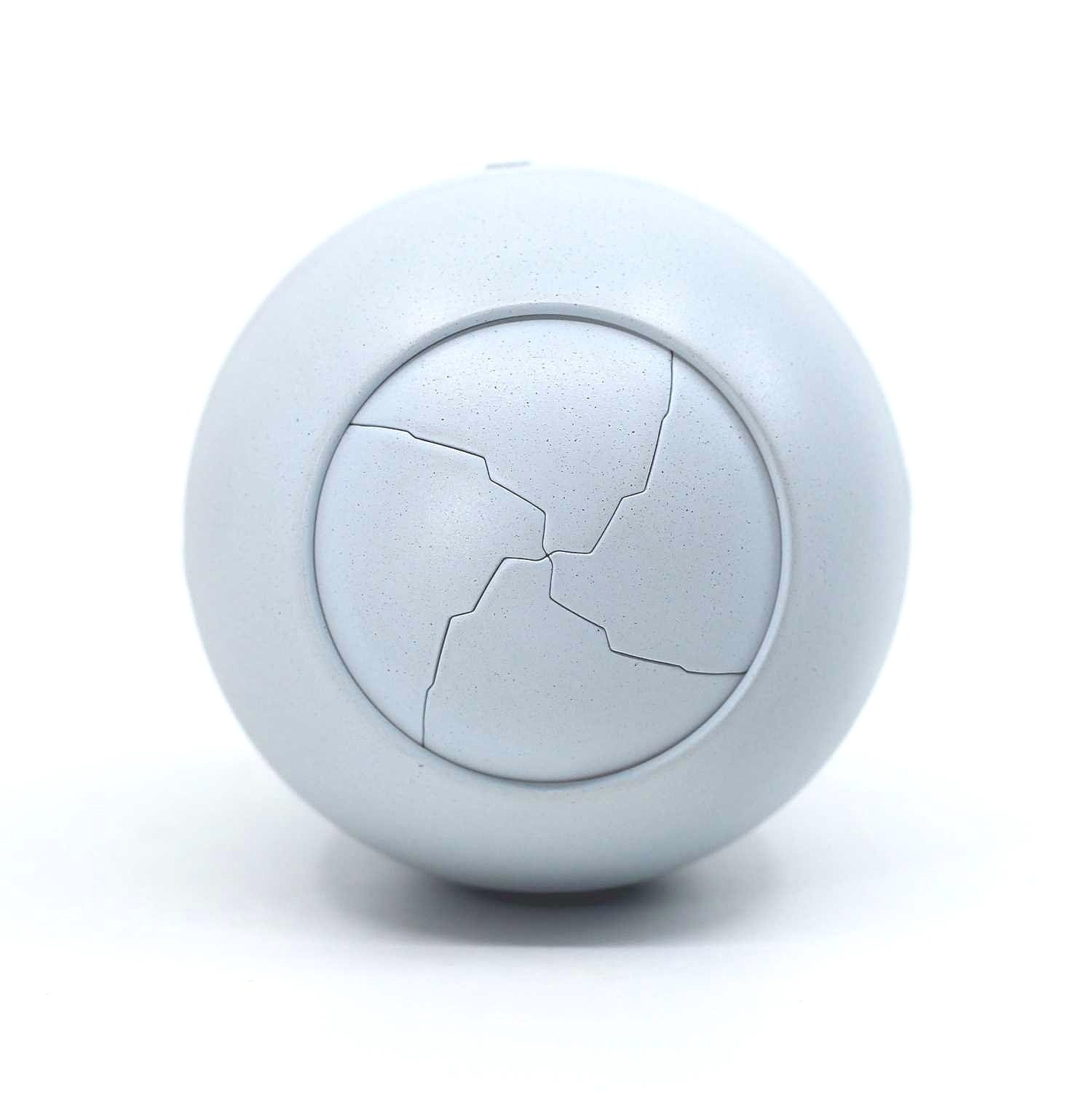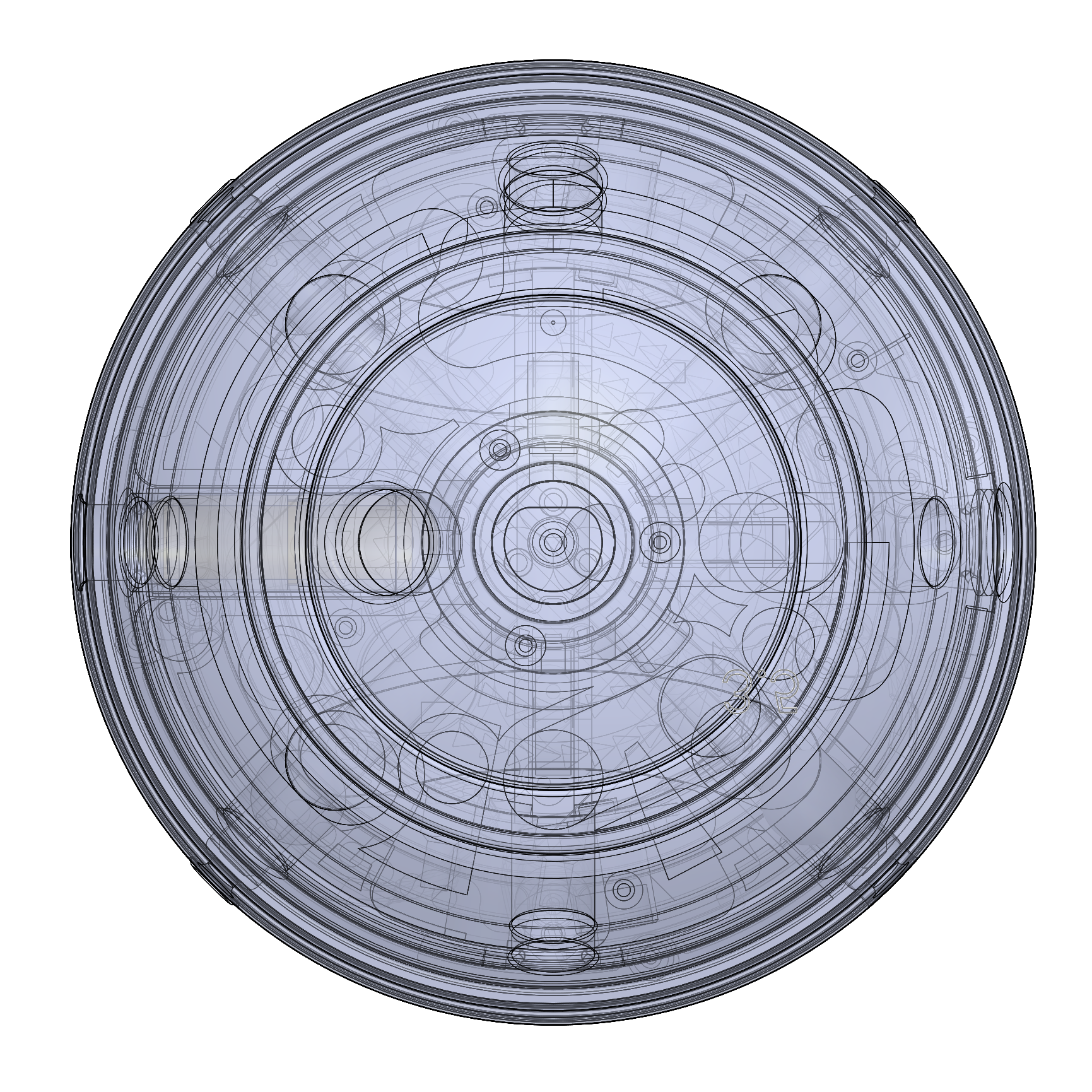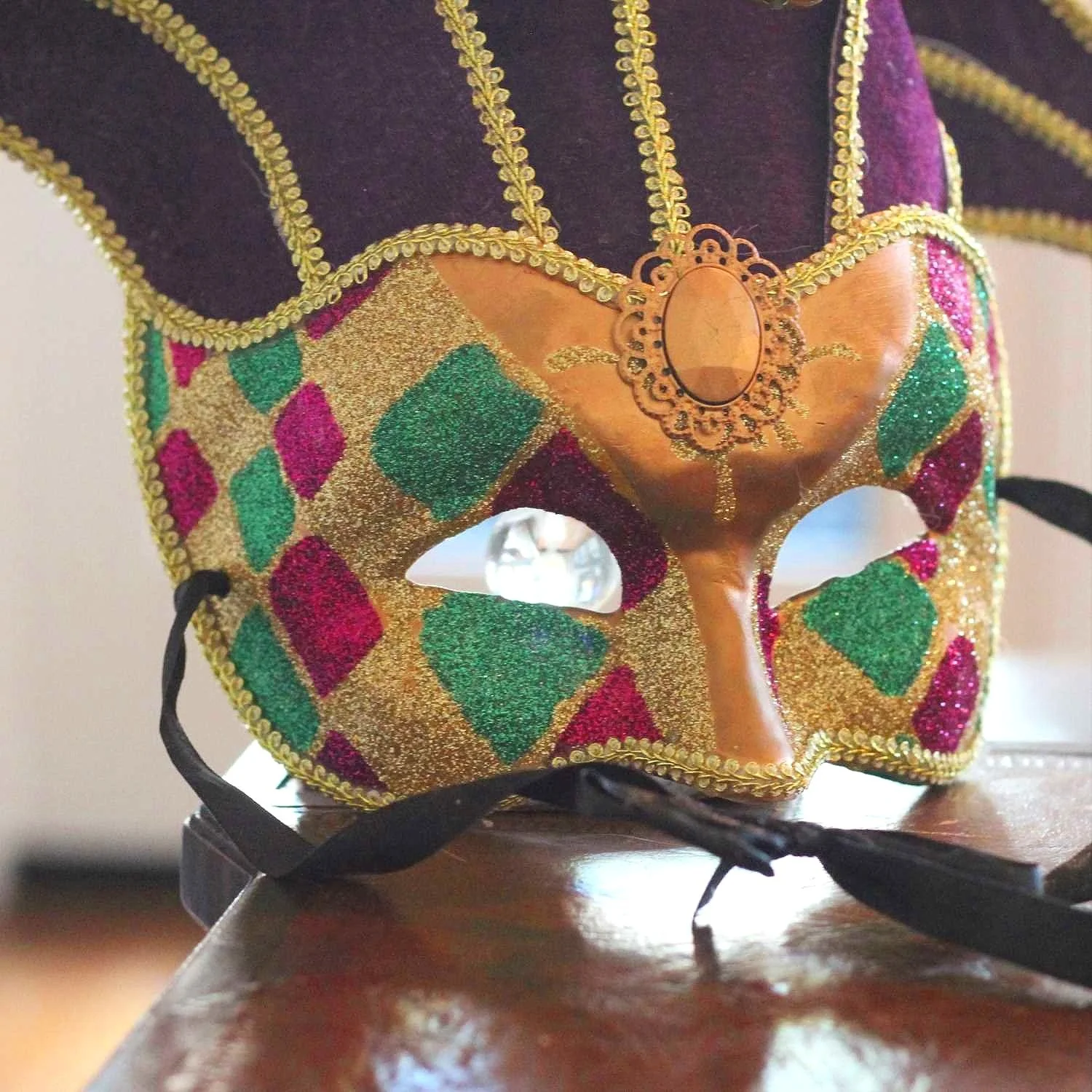Good Egg
Triple Yolk
Season’s Greetings everyone! I have something special in store for the holidays, so be on the hunt. Keep your eyes peeled, your wits unscrambled and your hunches hard boiled. Eggsceptional offerings are to be eggspected this time of year so let’s get cracking. You never know what you might unmask.
Triple Yolk by Lewis Evans
Professional prototyper, modeler and “miscellaneous” engineer Lewis Evans is a production wizard with a wicked sense of humor. He relates a story about going on holiday with a friend who asked to borrow some money a few years ago. Lewis was happy to lend the cash, but wasn’t going to make it so easy for his friend. He created a big brass cryptex puzzle, with the money secured inside, and handed it along with a little clue to his friend, as they were boarding the plane. Lewis has always been a tinkerer, making and building things. Fresh out of University he joined a small prototype engineering company called PD Models and has been creating things there for the past eighteen years. He now owns the company, which is essentially a one man show for 3D printing, vacuum casting, traditional model making, and stereolithography. He only started thinking more about making puzzles, with his unique skills and professional equipment, in his spare time, after frustrating his friend with that brass cryptex. He knew he wanted to revisit that cryptex, but improve it, and he had a lot of ideas. Those ideas, and the design process that followed over the past three to four years, ultimately led to the Triple Yolk.
a tough egg to crack
Triple Yolk is a beautifully crafted, challenging sequential discovery puzzle in the shape of a large egg. The simple goal is to find the three yolks. The very first iteration of the puzzle was actually a sphere, and centered around a showpiece mechanism which can still be found on the bottom of the final version. He envisioned that mechanism on one side of the sphere, and the layers of the cryptex (the original puzzle idea) on the other; but he quickly discovered that there was only so much room in a sphere and he was running out of space for mechanisms. He solved this problem by elongating one side, and the puzzle became an egg. He was originally going to call it the “Cryptegg”. Around this time he stumbled across (i.e. fell prey to internet search algorithms) a video of the Lotus puzzle by Dutch designer Wil Strijbos, and something cracked inside him (metaphorically speaking). He had discovered a whole new world of mechanical puzzles, and a new fascination with the sequential discovery genre.
an early sketch
photo courtesy of Lewis Evans
Lewis keeps a little notebook with him, full of his sketches and ideas, in which he says are an endless supply of projects that keep his brain “ticking and designing”, one of the reasons he now loves puzzles so much. After seeing the Lotus puzzle, more interesting ideas and mechanisms came into his mind, like a vision of the egg “cracking open”. Once he really started to design things he moved the project over to CAD software, where Triple Yolk went through about twenty different versions before he was finally satisfied. Some of that had to do with one complex mechanism in particular, which he was passionate about perfecting. His prototype tester became known as the “wigglemaster”, finding every conceivable way of outsmarting or bypassing the intended solution for this step. Lewis admits he almost gave up, agonizing about that mechanism to get it just right. Some have since criticized it for being too “blind” and therefore too difficult a step. Lewis did try to add a viewing window at one point, but this made the puzzle very easy. In the end, he opted for eggstremely difficult, over easy. Bah dum.
could this be an eggsit?
Triple Yolk is an extremely high quality piece that Lewis originally envisioned would be made out of aluminum. However production costs for that would have been prohibitive, and Lewis could not imagine anyone would pay so much for a new design from a new designer. Regardless, what he produced is just as nice (if not nicer), using 3D printing technology not available to most people. His printers are Poly Jet, which spray a fine line of photopolymer that is cured with UV light at each layer. The process affords incredible precision and a smooth finish which can’t be replicated by the “glorified glue guns” of mainstream printers. It is also an expensive and time-consuming process. He printed and manufactured the majority of the approximately fifty parts of the puzzle, sanded each printed piece, assembled and finally hand painted every puzzle. It was a labor of love that was only really “fun” for the first batch of twenty he made. The second and final batch of thirty were “tedious”. In the end it was all worth it, thanks to the incredible reception the puzzle has received.
original plans for the Death Star?
photo courtesy of Lewis Evans
An amusing story explains a quirk about this second batch of thirty puzzles, which are labeled “Triple Yoke”. The joke of the yoke is that after the six to eight month process of producing the remaining puzzles in the limited series, Lewis wrote the name wrong on the order he sent for the label transfers. As he sat sticking labels on the final boxes, his mind on autopilot, his wife walked by and asked why he had changed the name. What? Oh no! Oh … well. Triple Yoke it is. A bit of egg on his face, and too late to worry. I actually love it, but I tend to appreciate the sunny side up.
looks like the yokes on me
Lewis comments that the most interesting and rewarding part of the process was what he learned about puzzle design, by understanding the perspective of the solver and what someone is likely to experience when faced with the unknown. He thinks this is a critical skill of any great designer. “I learnt that Puzzles had a psychology to them. That’s what really interested me about their design. Designing them you are not really designing a thing , more an experience that will hopefully be enjoyed by the solver. So yes you really have to put yourself into the shoes of the solver if the design is going to be any good.”
I knew it was complicated but, this is ridiculous
photo courtesy of Lewis Evans
Having been inspired at one point by the Lotus puzzle, Lewis was naturally curious to see what the great designer Wil Strijbos might think of his new puzzle, and he almost got the chance. As it turns out, his puzzle tester (the “wigglemaster”) was attending an upcoming gathering where Strijbos would be in attendance, and would bring the new puzzle along for comments and feedback. Lewis was excited! The day prior to the event, the puzzle was dropped, and smashed into pieces. Lewis reassembled and restored this Humpty Dumpty, and to commemorate the story, and perhaps have the last laugh, painted a fine black crack running down that copy, making it unique. Lewis has more recently been busy assisting Robert Yarger with vacuum casting the Golem’s Heart puzzle, and has something else in his frying pan, too. He is working on his next idea, the “The Pin in the Pebble”, which will be an ultra-realistic vacuum cast “river pebble” with a brass pin inside. The “SD Pebble” will push the boundaries of what to expect from “plastic”, pushing the genre and materials into the higher ends of what is possible. Lewis Evans doesn’t do anything soft boiled.
I’ll confess something about this week’s holiday offering. I made the cocktail for it a month ago, and it has been quietly getting old ever since. There was a time that I, like some of you right now, would have been put off by this revelation, assuming quite wrongly that old nog ought not to be consumed by anyone but the nosiest of holiday guests. In fact it is just the opposite, and aged egg nog is even better. Egg nog has been around for centuries, having been enjoyed in various forms since it was first consumed as “posset” in medieval Britain, when it didn’t even include any eggs. George Washington famously served a loaded version to his guests during the winter holidays at Mount Vernon. There is a somewhat famous recipe attributed to him (likely due to the fame of his potent nog, but dating from the nineteenth century, well after is hosting days were long past), which instructs:
nog blog
“One quart cream, one quart milk, one dozen tablespoons sugar, one pint brandy, ½ pint rye whiskey, ½ pint Jamaica rum, ¼ pint sherry – mix liquor first, then separate yolks and whites of 12 eggs, add sugar to beaten yolks, mix well. Add milk and cream, slowly beating. Beat whites of eggs until stiff and fold slowly into mixture. Let set in cool place for several days. Taste frequently.”
Clyde Common’s Egg Nog by Jeffrey Morgenthaler
You’ll note the requirement to let it sit for a few days. Keep in mind, this only works for spiked egg nog, with at least 14% alcohol by volume (28 proof), which will kill all bacteria present. But while this was a necessity for the colonials, it has become an obsession for many modern day mixologists, whose extremely aged egg nogs are fan favorites at many well known bars around the country. Aging mellows the alcohol burn and enhances the underlying flavors to achieve an incredibly rich and nuanced drink. Aside from aging, the selection of base spirits can be a defining feature for your nog. Legendary bartender Jeff Morgenthaler’s tequila - sherry egg nog, which he created as a flex in 2009 to impress cool Portlanders too jaded for brandy and spiced rum, was meant as one of a weekly rotation of genre bending nogs for his winter menu. It became a sensation, has been in demand at his bar ever since, and is a fan favorite recipe for many nog lovers round the world. Morgenthaler suggests a simple overnight chill for his mixture, but he’s just being practical. Alton Brown, the science focused chef of Food Network fame, has a famous nog recipe that recommends up to six months of aging, and some folks age their nog literally for years. For me, one month was all I could take before enjoying this decadent treat. Happy Holidays - and happy hunting!
I’d put all of these in my basket
Clyde Common’s Tequila-Sherry Egg Nog by Jeff Morgenthaler
(for two servings)
2 large eggs
3 oz superfine sugar
2 oz anejo tequila
2 ½ oz Amontillado sherry
6 oz whole milk
4 oz heavy cream
In a blender on low speed , mix eggs until smooth. Slowly add sugar until dissolved. Slowly add remaining ingredients. Bottle and refrigerate overnight or up to one month (or more). Serve with freshly ground nutmeg dusted on top.
Explore more:











